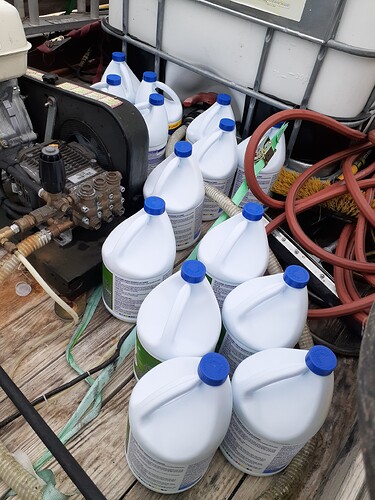Just thought I’d give you guys a laugh I haven’t had to do this in a long time but… I started out Friday with a fiver of 12.5 % and only had 1 house wash to do, with the amount of heat that we still have down here I wasn’t going to pick up another 55 til next week, I hate to have it just sitting around degrading and not use it.
Friday afternoon at 5 I get a text message and I got six more houses to do this weekend…lol… now I’m going job to job looking like Chuck in a truck off of Craigslist with a ton of 1 gallons in my trailer…
My ego is a bit bruised to say the least
Somebody can chime in at any time and tell me it doesn’t look that bad please… somebody… anybody
Nah, doesn’t look bad at all Chuck 
Dude SH doesn’t degrade that quick.
You can throw the jugs away but until you get rid of that square cage your still going to look unprofessional 
@sgb… the way that I use sh it would degrade fast enough, 2 weeks in the Charleston sun at 98° and you’d have a 55 of 8-6 %
Double like 

Oh I didn’t realize 55 gallons would last two weeks. You right playa. But you would have used about 20 gallons this weekend.
I feel personally attacked.
@sgb yeah up until about 2 months ago I was doing primarily restaurants and would go through a ton of degreaser… if I booked a bunch of houses close together I pick up a 55 of sh but normally I just grabbed fivers… now that I got this contract with this management company I’ve been doing anywhere from 2 to 8 houses a week on top of my restaurants slight learning curve on how to keep enough sh stalked on my trucks when I have no idea if I’m going to get to 20 houses to do LOL
I get it. Learning curves are fun. I’m still learning too.
What’s wrong with a tote?
LOL dang buddy. You recycled all that right?
They’re not designed for this use.
Hopefully they recycle.
Nothing if they are sitting in a job site somewhere. I’ve never seen a pic of one on this forum where it is properly secured. They aren’t designed to transport water around on a trailer with a ratchet straps over them lol
Darn, and I thought gravity alone was enough 
And two bungie cords.
They were literally made to store and transport bulk fluids lol.
Exactly. Ever see how they are secured when used for transport professionally? Not with home Depot ratchet straps hooked to the thin metals ribs.
@Innocentbystander
Well I never …
Actually they are designed to be transported all over the country with NO securement. Pretty much every one ever built was hauled on a trailer 2 wide and 11-12 deep 1000’s of miles with no straps. They are 100% DOT legal to transport liquids.
Caged IBC totes are one of, if not the most commonly used of all current intermediate bulk container design types. Caged IBC totes are handling and shipping containers for the storing, transit, and operation integration of various commodities, with the most common being water. Caged IBCs are often utilized as one-use containers, especially when it comes to hazardous materials, but are also suitable for reuse under many conditions.[1] This IBC type often features an interior liner, blow-mold manufactured from polyethylene, that is structurally supported by a protective cage frame, often of galvanized steel composition. Caged IBCs are engineered for the bulk handling of liquids, semi-solids, as well as solid materials. All materials can present certain safety and compatibility concerns, especially hazardous liquids[2]
Now, do they look cheap, and maybe not as professional as a $600 poly tank, well yes. BUT, they are actually designed for transport
This IBC design type is a composite intermediate bulk container, as defined within Title 49 CFR[3], and that has been tested and certified according to UN / DOT requirements for the transport and logistic handling of non-hazardous and hazardous materials, many times packing group II and III. Caged IBC containers can be fabricated according to various manufacturing requirements as well as construction materials for container durability and compatibility. The most commonly used caged IBC type and material are composite IBCs fabricated from high-density polyethylene within a galvanized steel frame, and used at capacities of 275 US gallons (1,040 L) and 330 US gallons (1,200 L).[4]


